Newtown is the largest town in Montgomeryshire and lies on the River Severn in the community of Newtown and Llanllwchaiarn. The origins of the town date back to the end of the 13th century, although its heyday was in the 18th and 19th centuries, when the town prospered around the growth of the textile and flannel industry, which was stimulated by the completion of the Montgomeryshire Canal. The Cambrian Mills, which opened in 1856, were the first steam-driven mills in Newtown and stood beside the canal terminus on the east bank of the Severn. The men and women of the community who fell during both World Wars are commemorated on the Newtown and Llanllwchaiarn Cenotaph, which is situated on the junction of the A483 (New Road) and Shortbridge Street. The cenotaph takes the form of a plain cenotaph on a three stepped base set in small memorial garden, with a Sword of Sacrifice positioned on its front face. The inscriptions of the fallen are engraved on all its faces and commemorate some 174 men who fell during the Great War and 42 men and women who fell during the Second World War. This page commemorates the fallen of the Second World War.
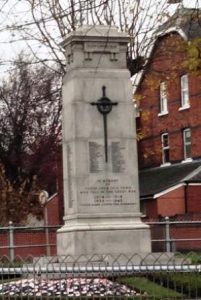
World War Two, 1939-1945
Walter Charles Benbow, Lance Corporal, 4030126, King’s Shropshire Light Infantry. Walter was the son of Charles Morgan Benbow and Alice Benbow (nee Pugh), of Ynyshir, Glamorgan. His mother was from Newtown and his uncle, Walter Pugh, died in the Great War. Walter enlisted into the army and was posted to the 1st Battalion, King’s Shropshire Light Infantry. The battalion was attached to the 3rd Infantry Brigade, 1st Infantry Division and was in France with the BEF at the outbreak of war, taking part in the withdrawal to Dunkirk, where the survivors were evacuated. The 1st Division was then rebuilt before being sent to North Africa in February 1943 to take part in the final stages of the Tunisian Campaign. The division landed on 9 March and was posted to the Medjez-Bou Arada sector, where it began patrolling and preparing for the final offensive of the campaign. Walter was killed in Tunisia on 8 April 1943. The 35-year-old is buried in Medjez-El-Bab War Cemetery, Tunisia. Walter is not commemorated on the Newtown war memorial.
George William Bevan, Lance Corporal, 2121002, Royal Engineers. George was born on 29 June 1914, the son of George Denley Bevan and Caroline Bevan (nee Parry), of Compton House, Frolic Street, Newtown. He worked as a painter and decorator prior to the war. George enlisted into the army and was posted to the 101st Field Company, Royal Engineers. George landed on the Normandy beaches with his company at some time after D-Day, 6 June 1944. He was killed almost a month later, on 5 July 1944, aged 30. George was originally buried on the battlefield southeast of Bayeux but on 3 October 1945 he was re-interred in Brouay War Cemetery, France.
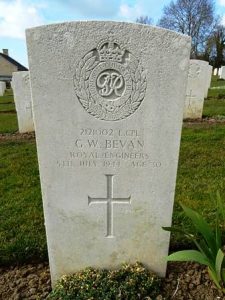
David Thomas Brown, Guardsman, 2735573, Welsh Guards. David was born on 9 November 1919, the son of Thomas Brown and Martha Anne Brown (nee Morgan), of 44, Bryn Street, Newtown. He worked for the Star Tea Company at Newtown prior to the war. David enlisted into the army and was posted to the 2nd Battalion, Welsh Guards. The battalion was raised by Royal Warrant on 18 May 1939, initially stationed at HM The Tower of London where they carried out Public Duties. On 22 April 1940 the 2nd Battalion, Welsh Guards moved to Old Dean Common, Camberley, where they formed part of the newly formed 20th Guards Brigade. The Germans invaded Holland and Belgium on 10 May 1940 and the 2nd Battalion, Welsh Guards was ordered to pack ready to proceed overseas. The battalion embarked at Dover aboard SS Biarritz on 21 May 1940 and disembarked at Boulogne the following day, with orders to defend the port to enable the evacuation of other troops and civilians. The Germans began probing the Boulogne defences that night, then on the following morning of 23 May 1940 launched a full-out assault against the port, supported by tanks and Stuka dive-bombers. David was killed in action during the fighting that day. The 20-year-old is buried in St. Martin-Boulogne Communal Cemetery, France. The survivors of the battalion were evacuated later that afternoon.
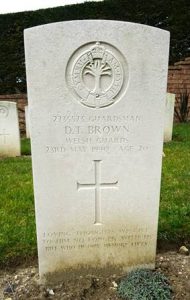
Richard Arthur Brumwell, Sergeant, 1580408, Royal Air Force Volunteer Reserve. Richard was born on 29 July 1923, the son of Thomas Llewelyn Brumwell and Sarah Olwen Brumwell, of Bodlondeb, Newtown. He was still at school when war was declared, and upon leaving enlisted into the Royal Air Force Volunteer Reserve. Richard trained as a Wireless Operator/ Air Gunner before being posted to 207 Squadron, Royal Air Force, which had moved from RAF Langar to the newly built RAF Spilsby, in Lincolnshire in October 1943. On 16 October 1944, Richard took off from Spilsby aboard Avro Lancaster I, Serial NG143, which had been despatched on a mine-laying mission over the North Sea. The Lancaster was intercepted by a German night fighter whilst over the North Sea and was shot down, with the loss of all her crew of seven men. Richard was 21 years old when he died that night and is commemorated on the Runnymede Memorial, Surrey.
Thomas Henry Bernard Clayton. Thomas, known as Bernard, was born in Newtown on 2 December 1901, the son of Harry and Amelia Clayton. He married Hilda May Mills in 1927 and the couple lived at 47, Park Street, Newtown. Bernard possibly served with the local Home Guards. He died at Newtown in 1941, aged 39. Bernard is not commemorated by the CWGC.
Edward Leslie Colley, Sergeant, 1103799, Royal Air Force Volunteer Reserve. Edward was born on 13 August 1913, the son of William Colley and Elizabeth Colley (nee Williams), of 7, Weir Street, Newtown. He worked as a boot shop assistant prior to the war. Edward enlisted into the Royal Air Force Volunteer Reserve and trained as an Air Gunner before being posted to 619 Squadron, Royal Air Force, which was a heavy bomber unit, based at RAF Woodhall Spa in Lincolnshire. The squadron moved to RAF Coningsby in January 1944, then to RAF Dunholme Lodge in April. On 10 August 1944, Edward took off from Dunholme Lodge aboard Avro Lancaster I, Serial ME866, which was part of a large force despatched to bomb oil storage dumps in the Foret de Chatellerault. Whilst flying over France on the outboard voyage, the Lancaster appears to have collided with another Lancaster of 50 Squadron and crashed at Thure, near Chatellerault, with the loss of six of her crew of seven. Edward was 30 years old and is buried besides his comrades in Thure Communal Cemetery, France.
Davies, E. This person cannot be identified, however an Ethel Davies, born 23 June 1903, of Greenbrook House, Newtown was a local evacuee helper and died at Newtown in 1945, aged 42.
John Idris Moss Davies, Leading Seaman, D/JX 138552, Royal Navy. John was born at Wrexham on 15 September 1917, the son of Llewellyn Moss Davies and Hannah Moss Davies (nee Jones). He married Ceinwen Morgan, of 4, Mount Pleasant, Newtown at Basingstoke in 1939. John enlisted into the Royal Navy and was posted aboard HM Submarine Usk. She had been built by Vickers Armstrong, at Barrow-in-Furness and was commissioned on 11 October 1940, before being despatched to the Mediterranean. Usk sailed from Malta to patrol off the northwest coast of Sicily on 19 April 1941 and was then ordered to alter her position due to intense anti-submarine activity. She disappeared at some time after 25 April 1941, possibly after striking a mine near Cape Bon, and was reported as overdue on 3 May 1941. John was 23 years old when he was lost in the sinking of Usk. He has no known grave and is commemorated on the Plymouth Naval Memorial, Devon.
John Richard Davies, Trooper, 14542818, Royal Armoured Corps. John was the son of Ernest Davies and Elsie Davies (nee Bellhouse), of Rosedene, Pool Road, Newtown. He enlisted into the army and was posted to the 11th Hussars. The regiment was in Egypt at the outbreak of war as part of the 7th Armoured Division and took part in the North African and Italian campaigns before being withdrawn to Britain to prepare for the invasion of Normandy. John probably joined the 11th Hussars following its return from Italy in 1944. The 7th Armoured Division landed at Gold Beach, Normandy on D-Day, 6 June 1944 and took part in the heavy fighting to break out of the beachhead. The division took part in Operation Perch and Operation Goodwood, two operations that formed part of the Battle for Caen but suffered heavy losses against the superior equipment of the Panzer-Lehr-Division and the Heavy SS-Panzer Battalion in the Battle of Villers-Bocage. Following the capture of Caen, the division took part in Operation Spring, intended to keep the Germans away from the Americans who were launching Operation Cobra and then in Operation Bluecoat, an attack to support the American break-out. John was killed during the fighting for the Falaise Pocket on 18 August 1944. The 19-year-old was originally buried on the battlefield near Le Hamel, France, alongside a fellow crewman, W. Finch, but on 16 August 1946 both men were re-interred in Banneville-la-Campagne War Cemetery, France.
Charles Kenneth Dyke, Fusilier, 14850220, Royal Welch Fusiliers. Charles, known as Kenneth, was the son of Fred Randolph Dyke and Edith Lillian Dyke (nee Lloyd), of 6, Frankwell Terrace, Llanllwchaiarn. He enlisted into the army and was posted to the Royal Welch Fusiliers. Charles served throughout the war and survived the conflict, but was found dead at Wartwith Hipswell, near Richmond, Yorkshire on 10 September 1947, aged 26. His remains were brought home and he was buried in Newtown and Llanllwchaiarn Cemetery four days later.
Hugh Richard Lewis Francis, Warrant Officer Class II, 4182421, Royal Welch Fusiliers. Hugh was the son of Richard and Sarah Jane Francis, of 1, Park Place, Park Street, Newtown. He worked as a grocer and had served during the Great War with the 7th Battalion, Royal Welsh Fusiliers, seeing action at Gallipoli and in Palestine before being invalided home. Hugh married Ada Davies at Newtown in 1923. He continued to serve with the 7th Battalion, Royal Welch Fusiliers after the war, and following the outbreak of the Second World War was posted to the 11th Battalion, Royal Welch Fusiliers, a reserve battalion. Hugh died at Newtown on 16 July 1941, aged 46. He is buried in Newtown and Llanllwchaiarn Cemetery.
George Kenneth Rowley Gwalchmai, Pilot Officer, 182371, Royal Air Force Volunteer Reserve. Gwalchmai was the son of George Gilbert Gwalchmai and Alice Lilian Irene Gwalchmai (nee Pugh), of Glynderw, Newtown. He enlisted into the Royal Air Force Volunteer Reserve and was posted as Flight Sergeant on 8 June 1944 before being posted to 3 Ferry Unit, Royal Air Force, which was based at Oujda, Morocco. On 23 November 1944 George was flying an Expeditor II, Serial HB250 of No 4 Ferry Unit when he flew into high ground near Naples in low cloud and was killed. The 22-year-old was buried in Naples War Cemetery, Italy.
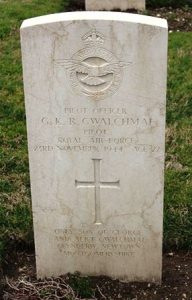
Harvey Roy Harris, Flight Sergeant, 1581276, Royal Air Force Volunteer Reserve. Harvey was the son of Martin Harris and Elizabeth Harris, of 44, Commercial Street, Newtown. He was master of the 1st Newtown Troop of Boy Scouts. Harvey enlisted into the Royal Air Force Volunteer Reserve in 1942 and was posted to Canada to train as a Navigator as part of the Empire Air Training Scheme. Upon completing his training Harvey returned to England and was posted to 466 (Royal Australian Air Force) Squadron. The squadron was originally equipped with Vickers Wellington medium bombers, based at RAF Leconfield, in Yorkshire, then converted to the Handley Page Halifax in late 1943, before returning to RAF Driffield and carried out operations on strategic targets in occupied France. On 15 October 1944 Harvey took off from RAF Driffield as Navigator aboard Handley Page Halifax III, Serial MZ299, which was part of a large force of bombers sent to destroy targets at Wilhelmshaven. Whilst nearing the target, the Halifax collided with another Halifax, Serial NP723 of 432 Squadron and crashed into the ground at Jackstede, some four miles west of Wittmund, killing six of seven of her crew. Harvey was originally buried with his crew in Wittmund Military Cemetery, but in 1947 their graves were exhumed and re-interred into Sage War Cemetery, Germany.
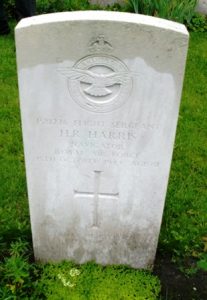
Norman Hilton, Pilot Officer, 182560, Royal Air Force Volunteer Reserve. Norman was the son of Richard Edward Hilton and Ida May Hilton (nee Hiscock), of 47, Broad Street, Newtown. He worked in a bank in London prior to the war. He enlisted into the Royal Air Force Volunteer Reserve and after completing his training as a Wireless Operator/ Air Gunner was posted to 206 Squadron, Royal Air Force. The Squadron was a Coastal Command unit, initially equipped with Avro Anson’s, with bases at RAF Bircham Newton, RAF Carew Cheriton and RAF Hooton Park on the Mersey. The Squadron re-equipped with Lockheed Hudson’s in April 1941 and a year later re-equipped with a number of Boeing Fortress II, which allowed the Squadron to carry out long range patrols over the Atlantic. The Squadron then re-equipped with the Consolidated Liberator VI and VIII and was based at RAF St. Eval until after D-Day, when the unit moved North to RAF Leuchars in Fife. On 15 July 1944 Norman was flying on a patrol over the Denmark Sea aboard Liberator VI, Serial EV947 when the German U-Boat U-319 was spotted. As the Aircraft attacked the U-Boat it was hit by flak and crashed into the North Sea with the loss of all ten of her crew. Norman’s body was recovered from the sea, one of just two recovered from the crash, and was brought home for burial in Newtown and Llanllwchaiarn Cemetery.
James Glyn Hunt, Corporal, 4208295, Royal Welch Fusiliers. James was born in London in 1922, the son of Alfred William Hunt and Sarah Hunt (nee Thomas). His father was an ex-serviceman and a Policeman in London, and his mother was from Newtown. The family had moved to Severn House, Severn Square, Newtown prior to the war, following his father’s retirement. James enlisted into the army and was posted to the 6th Battalion, Royal Welch Fusiliers, which was attached to 160 Brigade, 53rd (Welsh) Division. The battalion was mobilised at the outbreak of war, when the Division moved to Northern Ireland to begin garrison duties. The Division then moved to Pembroke Dock, before moving again to the south of England, where it trained in readiness for the D-Day Landings. On 24 June 1944 the 7th RWF left England for Normandy, and landed at La Riviere near Ver Sur Mer. The Division then took part in heavy fighting over the coming weeks, as part of the effort to break-out of the Normandy beachhead, seeing heavy fighting at Évrecy, before starting the epic advance through Northern France into Belgium and Holland. On 15 September the Division forced the crossing of the Junction Canal North of Lommel, and continued to push westwards towards Elst, between Nijmegen and Arnhem, during Operation Market Garden. James was killed during an assault on the village of Reusel on 25 September 1944. The 21-year-old was originally buried in Reusel, together with three other men killed during the assault, but on 30 May 1945 the men’s graves were re-interred into Valkenswaard War Cemetery, Netherlands.
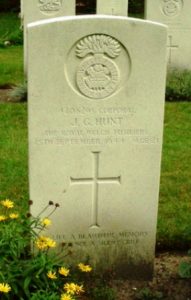
Albert Maldwyn James, Sergeant, 1178891, Royal Air Force Volunteer Reserve. Albert was the son of Albert Edward Ernest James and Mary Ann James (nee Williams), of 14, Dysart Terrace, Newtown. He worked in a garage in Severn Square prior to the war. Albert enlisted into the Royal Air Force Volunteer reserve and after completing his training as a Flight Engineer was posted to 57 Squadron, Royal Air Force. The Squadron had originally been part of the Air Component of the British Expeditionary Force and following the fall of France began carrying out anti-shipping strikes against the coast of Norway and moved to RAF Elgin in Scotland. The squadron moved to RAF Feltwell in November 1940 to re-equip with the Vickers Wellington, then in September 1942 moved to RAF Scampton and converted to Avro Lancaster’s. On 5 May 1943 Albert took off from Scampton aboard Lancaster III, Serial ED390, which was part of a large force of bombers sent to attack strategic targets in Dortmund. The Lancaster was intercepted by a German night fighter whilst on its outbound journey and was shot down, crashing at Brandlecht, some three miles southeast of Nordhorn, with the loss of all seven of her crew. Albert was 22 years old when he was killed in the crash. He was originally buried besides his fellow crewmen in Lingen New Cemetery, but on 2 June 1947 the men’s graves were re-interred into Reichswald Forest War Cemetery, Germany.
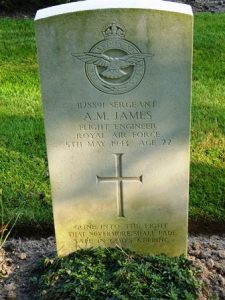
David Owen Jones, Sergeant, 1816948, Royal Air Force Volunteer Reserve. David was the son of John Gwilym Jones and Minnie Elizabeth Jones (nee Davies), of Dysart Terrace, Newtown. He worked in a solicitor’s office prior to the war. David enlisted into the Royal Air |Force Volunteer Reserve and after completing his training as a Flight Engineer was posted to 460 (Royal Australian Air Force) Squadron, Royal Air Force. The squadron had formed in November 1941 as a bomber squadron equipped with Wellington IV aircraft and originally joined No. 8 Group RAF, Bomber Command. The squadron then moved to RAF Breighton, Yorkshire and joined No. 1 Group RAF, making its first raid against the German city of Emden, on 12 March 1942. From August 1942 the squadron began re-equipping with Halifax II’s, then in October received its first Avro Lancaster’s, before moving to RAF Binbrook in Lincolnshire. On 18 November 1943 David took off from RAF Binbrook aboard Avro Lancaster I, Serial DC341, which joined a large force of bombers sent to destroy strategic targets in Berlin. The Lancaster was intercepted by a German night fighter and was shot down, crashing at Zornigall, some four miles East of Wittenberg with the loss of all seven of her crew. David was originally buried alongside his fellow crewmen in Zornigall Cemetery, but on 5 June 1947 their graves were re-interred into Berlin 1939-1945 War Cemetery, Germany.
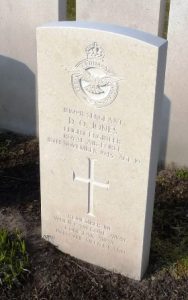
Emrys Evan Jones, Flight Sergeant, 1151000, Royal Air Force Volunteer Reserve. Emrys was the son of Evan Jones and Mary Jones (nee Morgan), of Nantoer, Newtown. He worked as a civil servant in London prior to the war. Emrys enlisted into the Royal Air Force Volunteer Reserve and after completing his training as a Pilot was posted to 138 Squadron, Royal Air Force. The squadron was a top-secret unit which had been reformed in 1941 as the first squadron of the Royal Air Force Special Duty Service and was equipped with Lysander’s and Armstrong Whitworth Whitley’s. It was initially based at RAF Stradishall in Suffolk and its role was to drop supplies and agents for the SIS and the SOE into Axis occupied territory. On 28 January 1941 Emrys was flying Whitley V, Serial Z6728 and had managed to successfully drop off a Special Operations Executive agent near Musjide, in Belgium. The Whitley was returning to Stradishall when it suffered an engine failure and crashed into the English Channel, with the loss of all six of her crew. The bodies of two men were later recovered from a dinghy which washed ashore at Hawkinge, Kent almost two weeks later. Emrys was 20 years old when he died in the crash of his Whitley. He has no known grave and is commemorated on the Runnymede Memorial, Surrey.
John Ernest Jones, Private, S/263025, Royal Army Service Corps. John was the son of David Edward Jones and Alice Elizabeth Jones, of 6, Park Terrace, Newtown. He worked as a baker prior to the war and married Emma Timmins at Cannock, in 1939. John enlisted into the Royal Army Service Corps and was posted to North Africa with the 13th Field Bakery, RASC. Each Division of the British Army was equipped with a Field Bakery, and the bakeries were housed in motor lorries. John died in Egypt on 9 January 1943, aged 25. He is buried in Fayid War Cemetery, Egypt.
Kenneth Roderick Harry Jones, Aircraftman, 1384908, Royal Air Force Volunteer Reserve. Kenneth was the son of Roderick Protheroe Jones and Kathleen Averna Jones of 170, Ballard Lane, Church End, Finchley, Middlesex. He was the grandson of Harry Jones, of 5 Kerry Road, Newtown. Kenneth enlisted into the Royal Air Force Volunteer Reserve and after completing his training as a Wireless Operator/ Air Gunner, was posted to No 14 Advanced Flying Unit at RAF Ossington, in Nottinghamshire, for further training. On 13 February 1943 Kenneth took off from Ossington aboard Airspeed Oxford I, Serial V3948, flown by Pilot Officer Donald Robert Reid. The aircraft stalled during the flight and crashed near Cowbit, some four miles southeast of Spalding, in Lincolnshire, killing both men. Kenneth was 20 years old when he was killed in the crash. His remains were recovered from the wreckage and brought home and he was buried in St. David’s Churchyard, Newtown on 9 March.
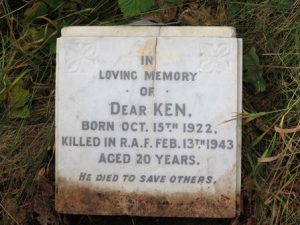
Lloyd Jones, Fusilier, 14541644, Royal Fusiliers (City of London Regiment). Lloyd was the son of Richard Francis Jones and Mary Jones (nee Rees), of Lower Brimmon Farm, Newtown. He enlisted into the army and was posted to the 1st Battalion, Royal Fusiliers. The battalion was attached to the 17th Indian Infantry Brigade, 8th Indian Infantry Division. The Division had spent much of the war in Persia, then moved to Damascus in March 1943 where it carried out some intensive training, notably in mountain warfare and combined operations. In June 1943 the division was selected to participate in the anticipated Dodecanese Campaign, but following the Italian surrender the Division was redirected to Italy to help in the campaign to drive the German occupiers out of the country. On 24 September 1943 the 8th Indian Division landed in Taranto, before joining the advance northwards through the mountainous country, which included a series of river crossings. The Division took part in the terrible fighting during the crossings of the Biferno and Trigno in October 1943, before advancing to the Sangro River. Lloyd was killed just after the crossing of the Sangro, on 27 November 1943. The 19-year-old is buried in Sangro River War Cemetery, Italy.
George Bertram Knightley, Corporal, 950227, Royal Air Force Volunteer Reserve. George was born in Ware, Hertfordshire on 11 October 1914, the son of James Edward Knightly and Ella Mary Knightley (nee Ellison). His father died in 1927, so Ella moved back to her native Newtown with George, and they lived at 12, Severn Street. George then worked as a clerk for his grandfather’s Solicitor’s business at Newtown upon leaving school. By the time war erupted George was working as a clerk for the Montgomeryshire Farmers’ Association. He enlisted into the Royal Air Force Volunteer Reserve and was posted to RAF Seletar, in Singapore. Singapore was the foremost British military base and economic port in South–East Asia and was known as the ‘Gibraltar of the East’. It was strongly garrisoned and was thought to be impregnable. On 8 December 1941 the Japanese launched a series of simultaneous attacks against Pearl Harbour, Malaya, Thailand and the Pacific Islands. The Japanese had a force of some 30,000 troops involved in the Malayan invasion but soon reached the outer defences of Singapore following a short period of intense fighting. General Percival, commanding a garrison of some 85,000 troops in Singapore was ordered by Winston Churchill to fight to the last man, however, on 15 February 1942 he surrendered, and 80,000 troops were marched into captivity. George was captured in Singapore and was among a large number of men taken to POW camps in Java. On 25 November 1943 George was among some 547 prisoners who embarked from Ambon aboard the Japanese ‘Hellship’ SS Suez Maru. On 29 November 1943, Suez Maru was steaming off Kangean Island, east of Madoera Island, when she was hit by a torpedo which had been fired by the American submarine USS Bonefish. Many of the prisoners drowned in the hold, whilst others who managed to take to the water were left by the Japanese and either drowned or were machine-gunned by the Japanese. A memorial to the 414 British POWs aboard Suez Maru who were murdered by the Japanese was dedicated on 29 November 2013 at the National Memorial Arboretum, Alrewas, Staffordshire. George was 29 years old when he died during the sinking of Suez Maru. He has no known grave and is commemorated on the Singapore Memorial, Singapore.
Adrian Sigbert Terence Leach, Squadron Leader, 85484, Royal Air Force Volunteer Reserve. Adrian was the son of Alfred Leach and Leonora Marsden Leach (nee Smith), of Nant-y-Gwyn, Newtown. He was educated at the University of Wales, gaining his BSC, before becoming a teacher at Epsom, Surrey. Adrian married Rosa Ellen Ward, a schoolteacher from Ashtead in 1940. He enlisted into the Royal Air Force Volunteer Reserve soon after the outbreak of war and by 25 November 1940 had been promoted to Pilot Officer. Adrian served throughout the entire war and by the end of hostilities had gained the rank of Squadron Leader. He became ill after the war and died at Hampstead General Hospital, Haverstock Hill, London on 3 April 1946, aged 35. Adrian was buried in St. Giles Churchyard, Ashtead.
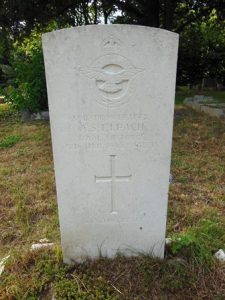
David Richard Lewis, Sergeant, 1583571, Royal Air Force Volunteer Reserve. David was born on 25 July 1923, the son of Evan Thomas Lewis and Margaret Jane Lewis (nee Watkin), of 36, Canal Road, Newtown. He worked as an ironmonger’s assistant prior to the war. David enlisted into the Royal Air Force Volunteer Reserve and after completing his training was posted to 524 Squadron, Royal Air Force, which was an RAF Coastal Command unit. The squadron had initially formed at RAF Oban, Argyll and Bute on 20 October 1943 to operate the Martin PBM Mariner flying boat, but by the time it had been evaluated, the RAF decided not to use it. The squadron was then reformed at RAF Davidstow Moor on 7 April 1944 to operate the Vickers Wellington. Its role was to carry out night operations over the French coast in preparation for D-Day, mainly attacking E-boats, submarines and other shipping. After D-Day the squadron moved to RAF Docking to carry out similar operations along the Dutch coast, before moving to RAF Langham in Norfolk, where it continued its operations. David was killed on 25 February 1945 whilst flying on a patrol aboard Vickers Wellington XIV, Serial HF283, which was lost with all her crew whilst on operations over the North Sea. The 21-year-old has no known grave and is commemorated on the Runnymede Memorial, Surrey.
James L’Homme, Private, 4194092, Parachute Regiment. James was the son of Thomas L’Homme and Emily Jane L’Homme (nee Franks), of Rosedene, Milford Cottages, Newtown. He worked in an oil depot in Newtown prior to the war. James enlisted into the army and was posted to the 10th Battalion, Royal Welsh Fusiliers. In August 1942 the battalion was converted from an ordinary infantry unit into the 6th (Royal Welch) Parachute Battalion, as part of the 2nd Parachute Brigade. The Brigade embarked for North Africa in April 1943 to prepare for operations in Sicily and Italy. The Brigades first operation was cancelled, whilst the 1st Parachute Brigade landed in Sicily where it suffered heavy casualties. In the meantime, plans were put into place for Operation Slapstick, the landings at Taranto. The 2nd Parachute Brigade left Bizerta on 8 September, the day before the Italian surrender, and landed unopposed, however James was aboard a transport ship, HMS Abdiel, which struck a mine and sank whilst entering the port on 10 September 1943, going down with the loss of fifty-eight men from the 6th Parachute Battalion. James was 19 years old when he was killed in the sinking of HMS Abdiel that day. His body was recovered from the sea, and he was buried in Bari War Cemetery, Italy.
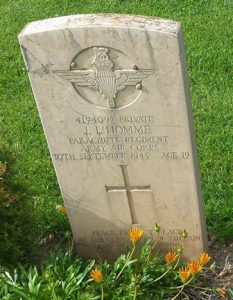
Dennis Arthur Mills, DFM, Flight Sergeant, 1509562, Royal Air Force Volunteer Reserve. Dennis was the son of Charles Winston Redvers Mills and Martha Matilda Mills, of Rhoslyn, Pool Road, Newtown. He worked as a baker prior to the war. Dennis enlisted into the Royal Air Force Volunteer Reserve and after completing his training as an Air Gunner was posted to 156 Squadron, Royal Air Force. The squadron was an elite Pathfinder unit, which had converted to Avro Lancaster’s in January 1943, based at RAF Warboys. On 2 January 1944 Dennis took off from Warboys aboard Avro Lancaster III, Serial JB703, which was part of a force despatched to mark strategic targets in Berlin in preparation for a larger raid comprising some 421 Lancaster’s. The force was targeted by German night-fighters as it approached the target area and Dennis’s Lancaster was shot down, crashing with the loss of all seven of her crew. Dennis was 20 years old when he was killed in the crash. He was originally buried besides his fellow crewmen in Döberitz-Elsgrund Friedhof, but on 3 December 1946 their graves were re-interred into Berlin 1939-1945 War Cemetery, Germany. He had been awarded the Distinguished Flying Medal during his short time at war.
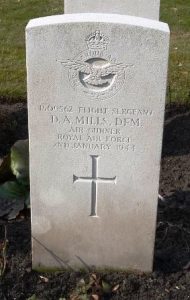
James Arthur Morgan, Private, 14374266, South Wales Borderers. James was the son of Arthur Morgan and Emily Morgan (nee Williams), of 52 Commercial Street, Newtown. He worked as a carpenter prior to the war. James enlisted into the army and was posted to the 2nd Battalion, South Wales Borderers. The battalion had taken part in the ill-fated Norwegian campaign in 1940 before being evacuated following the surrender of Holland and France and spent most of the war on home service. In March 1944 the battalion was selected to become the only Welsh unit to land on the Normandy beaches on D-Day and began training for its role before moving to its assembly area in the south of England. On 5 June the battalion embarked in a number of assault craft and at dawn on 6 June 1944 landed at Hable de Hertot before capturing the bridgehead at Vaux-sur-Aure. The battalion saw its first major action during an assault on the Chateau de Sully, near Bayeux. Over the coming weeks the battalion took part in the bitter fighting for Caen. James was killed in action during this period, on 30 July 1944, aged 20. He was originally buried on the battlefield near Granville, but on 1 June 1945 the war graves in the area were re-interred into Hottot-Les-Bagues War Cemetery, France.
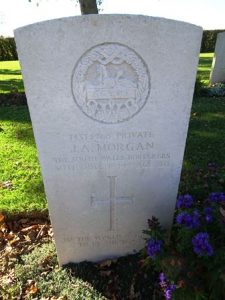
Dorothy Isa Gray Morrhall, Warrant Officer Class II, W/6701, Auxiliary Territorial Service. Dorothy was born on 1 February 1919, the daughter of George Cowie Gray and Lilian May Gray (nee Buckley). Her father served with the New Zealand Expeditionary Force during the Great War and was killed in France on 4 November 1918. Dorothy’s mother married Leonard Alva Pailing in 1923 and the couple moved to Pump House, Canal Road, Newtown, where Leonard raised Dorothy as his own daughter. Dorothy worked as a secretary at the Newtown Co-Operative Society prior to the war. She married Second Lieutenant Edward Geoffrey Morrhall, of Ellesmere, in 1942. Dorothy enlisted into the Auxiliary Territorial Service and was posted to the army camp at Salisbury Plain. She was killed during an accident there on 23 October 1943. The remains of the 24-year-old were brought home and she was buried in St. Llwchaiarn’s Churchyard, Llanllwchaiarn. (The photograph of Dorothy was taken on her wedding day and is courtesy of the NLW).
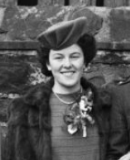
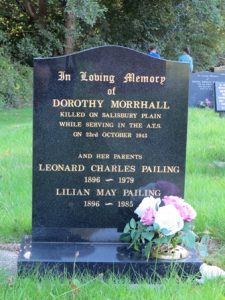
Herbert Victor Ockwell, Staff Sergeant, 831885, Glider Pilot Regiment. Herbert was the son of William George Ockwell and Rose Ockwell (nee Sims), of Marlborough. He enlisted into the army and became a pilot with the Glider Pilot Regiment following its formation in 1942. Herbert married Dyfi Sybil Elizabeth Parry, of 2, Cross Street, Kerry Road, Newtown whilst on leave in Wiltshire early in 1944. Herbert served with A Squadron, 1 Wing, Glider Pilot Regiment, which was a unit of the Army Air Corps, and his role as a glider pilot was to fly the Airspeed Horsa 1 glider, which could hold 30 fully equipped troops. The Glider Pilot Regiment had its baptism of fire during the airborne operation of Operation Husky, the invasion of Sicily, in 1943. The regiment then returned to England to train fort the forthcoming Normandy Landings. The airborne element of the D-Day landings, codenamed Operation Tonga, was a considerable force, with the British alone sending some 8,500 paratroopers into Normandy in the hours preceding the main beach landings, to secure strategically vital points. Herbert took off from RAF Harwell in Berkshire at 23.15 on 5 June 1944 flying Glider 66, as part of a flight of three gliders holding fifty highly trained paratroopers and eight Royal Engineers sent to assault and destroy the Merville battery, which was of considerable danger to the main seaborne landing force which was making its way across the Channel. As the gliders approached the landing site near Merville, Herbert’s Horsa was prematurely cut loose from its tow-plane. Despite this, Herbert managed to land the Horsa, but it struck an anti-glider pole and crashed, killing Herbert and several other men. Herbert was 27 years old when he was killed during the early hours of D-Day, 6 June 1944. He is buried in Ste Marie Cemetery, Le Havre, France.
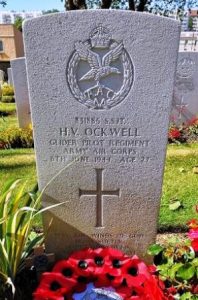
Henry Joseph Perkins, Driver, T/67801, Royal Army Service Corps. Henry was born in 1906. He married Helen Reynolds at Newtown in 1932 and the couple lived at 3, Francis Court, Newtown, where their son Henry was born the following year. Henry worked as a driver prior to the war. He enlisted into the army and with his experience was posted as a Driver with 1 Reserve Motor Transport Company, Royal Army Service Corps. Henry was most probably serving in Greece when the Germans launched their assault on the country on 6 April 1941 and was killed there on 18 April 1941, aged 34. Henry has no known grave and is commemorated on the Athens Memorial, Greece.
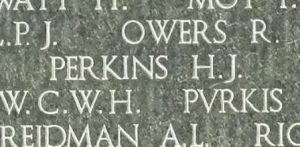
David Anthony Phillips, Leading Aircraftman, 945028, Royal Air Force Volunteer Reserve. David was the son of Gilbert Norton Phillips and Martha Louise Phillips, of Newtown. He enlisted into the Royal Air Force Volunteer Reserve, and was posted to Canada, to train as a pilot under the Empire Air Training Scheme. Upon arrival David was taken on strength at No. 2 Elementary Flying Training School at Fort William, Ontario, and was then posted to No. 4 Training Command at Penhold, Alberta, to train with No. 36 Service Flying Training School. On 24 December 1941, David and another student, Leading Aircraftman Bushell, were taking part in a cross-country exercise, flying an Airspeed Oxford I, Serial AS523, when the aircraft struck trees and crashed near Red Deer, Alberta, seriously injuring both men. David died of his injuries two days later, on 26 December 1941, aged 20. His fellow student died of his injuries on 6 January 1942. David was cremated at Calgary Crematorium, and his cremated remains were later brought home from Calgary and buried in the family plot in St. Gwynog’s Churchyard, Aberhafesp on 16 May 1942. His parents were later buried with him.
Derrick Rowley Owen Pugh, Sergeant, 1581750, Royal Air Force Volunteer Reserve. Derrick was the son of Ernest Rowley Pugh and Mary Elizabeth Pugh (nee Blayney), of 9, Kerry Road, Newtown. He worked as a reporter for the Montgomeryshire Express prior to the war and had served with the local Home Guard before enlisting into the Royal Air Force Volunteer Reserve in 1942. Derrick then trained as a Navigator before being posted to 625 Squadron, Royal Air Force, which was based at RAF Kelstern, in Lincolnshire. On 23 October 1944 Derrick took off from Kelstern aboard Avro Lancaster III, Serial PB531, which was part of a large force of bombers sent to hit strategic targets in Essen. The Lancaster was lost without a trace during the operation, with all seven of her crew missing, presumed killed. Derrick was 21 years old when he died that night. He has no known grave and is commemorated on the Runnymede Memorial, Surrey.
John Dennis Richards, Leading Aircraftman, 629859, Royal Air Force. John was the son of John Sidney and Ann Jane Richards (nee Williams), of 43, Kerry Road, Newtown. He enlisted into the Royal Air Force prior to the war and was based at RAF Habbaniya in Iraq. John was killed when the airfield was attacked by enemy aircraft on 2 May 1941. The 25-year-old is buried in Habbaniya War Cemetery, Iraq.
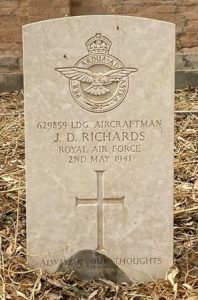
David Llewelyn Roberts, Trooper, 7880454, Royal Tank Regiment. David was the son of David Edward Roberts and Elizabeth Roberts, of 4, Sheaf Street, Newtown. He worked as a labourer at Walton-on-Thames prior to the war and married Emily Rose Hoare, of Hersham, Surrey on 3 April 1937. David enlisted into the army soon after the outbreak of war and was posted to the 7th Royal Tank Regiment. The unit was part of the Royal Armoured Corps and first saw action in France with the BEF in May 1940 before abandoning its vehicles and being evacuated from Dunkirk. The regiment then re-equipped before embarking for North Africa later that year and in December 1940 saw its first action in Egypt when it fought and destroyed an Italian group. The regiment also participated in the successful attacks on Italian-held Bardia. In mid-1942, the 7th Royal Tank Regiment was captured at Tobruk during the Battle of Gazala, part of the First Battle of El Alamein, when Tobruk was surrendered to the Axis forces on 21 June 1942. David died in captivity in North Africa on 14 November 1942. The 34-year-old has no known grave and is commemorated on the Alamein Memorial, Egypt.
John Henry Roberts, Sergeant, T/228261, Royal Army Service Corps. John was born on 17 September 1907, the son of John Roberts and Mary Roberts, of Mount Pleasant Cottage, Llanfair Road, Newtown. He married Vera Doris Lewis, of Bettws Cedewen and the couple moved to 48, West Street, Wilton, Wiltshire where John had gained a position as an insurance agent. He enlisted into the army and was posted to the Royal Army Service Corps. John was accidentally killed during an exercise in Surrey on 18 June 1942. The remains of the 34-year-old were brought home and he was buried in Bettws Calvinistic Methodist Cemetery.
Thomas Robert Wade Roberts, Pilot Officer, 177560, Royal Air Force. Thomas was the son of David Charles Roberts and Alice Roberts (nee Bumford), of Fronlas, Llanllwchaiarn. He worked as a chauffeur prior to the war. Thomas enlisted into the Royal Air Force Volunteer Reserve and after training as a Flight Engineer was posted to 434 (Royal Canadian Air Force) Squadron, Royal Air Force, at RAF Croft, in Yorkshire. The squadron was first formed at RAF Tholthorpe on 13 June 1943, flying the Handley Page Halifax V. In May 1944 the unit received Halifax IIIs and was adopted by the Rotary Club of Halifax, Nova Scotia and to show its connection to the city adopted the nickname “Bluenose Squadron”, the common nickname for people from Nova Scotia. The squadron moved to RAF Croft in December 1943 and continued operations over occupied Europe. On 13 June 1944 Thomas took off from Croft aboard Handley Page Halifax III, Serial MZ293 as part of a large force of 671 aircraft sent to bomb lines of communications leading to the Normandy area. Thomas’s aircraft was part of a group sent to bomb targets around Arras. The Halifax was brought down near Dunkirk with the loss of all of her crew of seven during the raid. Thomas was 20 years old and is buried in Dunkirk Town Cemetery, France.
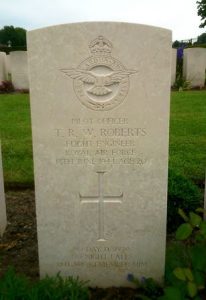
Walter Clive Rowlands, Sergeant, 1575968, Royal Air Force Volunteer Reserve. Walter was the son of John Wilfred Rowlands and Amelia Rowlands (nee Davies), of 10, Dinam Terrace, Canal Road, Newtown. He served with the local Home Guard before enlisting into the Royal Air Force Volunteer Reserve and after completing his training as an Air Gunner was posted to 9 Squadron, Royal Air Force, at RAF Bardney, Lincolnshire. On 26 June 1943 Walter took off from Barney aboard Avro Lancaster III, Serial ED831, which was part of a large force of aircraft sent to bomb targets in Gelsenkirchen. The Lancaster was intercepted by a German night fighter on the outbound journey and was shot down, crashing into the IJsselmeer near Hoorn, Netherlands with the loss of all seven of her crew. Walter was 20 years old when he died that night. His body was later recovered from the canal, and he was buried in Amsterdam New Eastern Cemetery, Netherlands. His father, John Wilfred Rowlands, died on active service in 1940.
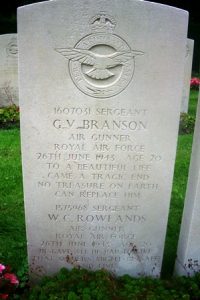
John Wilfred Rowlands, Fusilier, D/4801, Royal Welch Fusiliers. John was born on 24 May 1886, the son of Richard Rowlands and Mary Harriett Rowlands, of Aberhafesp. He had worked as a Drapers Assistant prior to the Great War and had enlisted into the Royal Air Force on 22 June 1918. After being demobilised John married Amelia Davies at Wigan in 1920. The couple then moved to 10, Dinam Terrace, Canal Road, Newtown. John re-enlisted at the beginning of the Second World War and was posted to the 11th Battalion, Royal Welch Fusiliers. He died on active service on 11 June 1940, aged 54. John is buried in Newtown and Llanllwchaiarn Cemetery. His son, Walter Clive Rowlands, was killed whilst serving with the Royal Air Force in 1943.
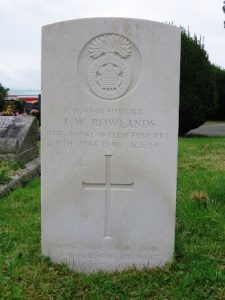
John Albert Sigley, Chief Steward, Merchant Navy. John was born at Birkenhead on 15 December 1905, the son of John Thomas Sigley and Elizabeth Sigley (nee Cubbins). He left home as a young man to go to sea with the Merchant Navy. John married Doris Day at Birkenhead in 1931 and the couple set up home together at 21, Crescent Street, Newtown. John went back to sea, while Doris kept busy working as a shop assistant. By the time war broke out, John was serving aboard the SS Robert L. Holt. On 3 July 1941 Robert L. Holt was steaming with Convoy OB-337 south of Gran Canaria when she was attacked by the surfaced German submarine U-69, which began firing her deck gun and machine guns at the defenceless Merchant vessel. The doomed vessel sank two hours later, with the loss of 55 lives. John was 35 years old when he was killed that day and is commemorated on the Tower Hill Memorial, London. John is not commemorated on the Newtown war memorial.
John Henry Stephens, Private, T/131593, Royal Army Service Corps. John was born at Aberystwyth on 19 June 1904, the son of Richard Stephens and Fanny Stephens. By 1911 the family had moved to Nicholls Court, Kerry Road, Newtown. John married Doris Thomas, of Newtown in 1933 and by 1939 the couple were residing at 6, Nantiesyn, Tywyn, where John worked as a lorry driver. John enlisted into the Royal Army Service Corps soon after the outbreak of war. He died on active service at Brecon on 22 December 1939, aged 35. John’s remains were brought home and he was buried in Newtown and Llanllwchaiarn Cemetery on 26 December. John is not commemorated on the Newtown war memorial.
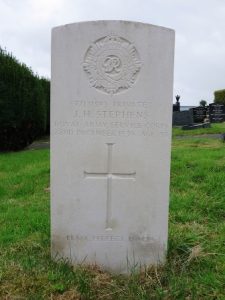
Talbot, J. T. Cannot presently be identified.
Gerald Ernest Tudor, Flight Sergeant, 1414899, Royal Air Force Volunteer Reserve. Gerald was born on 28 March 1921, the son of Edward Tudor and Mary Tudor (nee Kinsey), of Bryn Street, Newtown. He worked as a labourer and was a member of the local Home Guard before enlisting into the Royal Air Force Volunteer Reserve. Gerald was posted to 99 Squadron, Royal Air Force. The squadron was the first unit to be equipped with Vickers Wellingtons, just before the start of World War II and flew its first operational mission of the war on the night of 8/9 September 1939. After carrying out missions against German shipping the squadron bombed targets in Norway and Germany, before being transferred to RAF Dhubalia in India in February 1942 and resumed operations in November 1942 against Japanese bases in Burma. From September 1944 the squadron re-equipped with Consolidated Liberators which allowed it to reach targets in Thailand and Malaya. On 3 December 1944 Gerald was flying aboard a Liberator BVI, Serial KG973 on a raid to bomb railway yards at Hnong Pladuk, Thailand, when the aircraft collided with another Liberator and crashed into the sea off the coast of Burma, killing all eleven crewmen aboard. The other Liberator suffered the same fate. Gerald was 21 years old when he was killed in the resulting crash that day. He is commemorated on the Singapore Memorial, Singapore.
Edward Thomas Williams, Fusilier, 4189647, Royal Welch Fusiliers. Edward was the son of Evan Evans Williams and Ann Jane Williams (nee Jones), of Bwlchyllyn Isaf, Trefeglwys. He married Annie May Humphreys, of Llandinam, at Newtown in 1939. Edward was a regular soldier, and was serving with the 1st Battalion, Royal Welch Fusiliers at the outbreak of war. The battalion embarked for France with the BEF and took up positions on the River Dyle at Ottenburg, north of Wavre, where the battalion first made contact with the attacking Germans on 14 May 1940. The forward company was subjected to intense mortar fire and a series of unsuccessful attacks throughout the following day. Meanwhile the Germans had broken through near Sedan, threatening the southern flank of the BEF, and orders for the Battalion to withdraw came on the night of 15-16 May. There was no transport available initially, so the men were forced to withdraw on foot, digging in at night in case of further attacks. Trucks arrived on 18 May and took the Battalion to Tournai on the Escaut where they held the river line under heavy fire for two days. Late on 20 May, with the German forces again threatening to outflank the BEF, the 1st RWF were told to withdraw to the area north of Béthune, where they arrived on 24 May, but the shattered battalion was then ordered to advance westward to capture four bridges over the La Bassée Canal, south of Saint-Venant. The first attack was carried out on the evening of 24 May and the battalion captured Saint-Floris but could not force their way into Saint-Venant. Fighting raged overnight and during the following days. Edward was killed in action during desperate fighting on 25 May 1940. The 31-year-old is buried in Burbure Communal Cemetery, France.
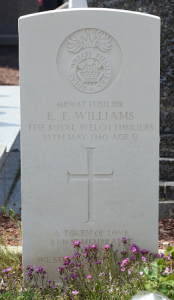
George Ivor Maurice Williams, Fusilier, 4195077, Royal Welch Fusiliers. George was the son of George Richard Williams and Fanny Williams (nee Thomas), of 38 Park Street, Newtown. He worked in a sawmill prior to enlisting into the Royal Welch Fusiliers, and embarked for France with the BEF, being attached to the 50th Company, Auxiliary Military Pioneer Regiment, Pioneer Corps, which had been formed mainly from Army Reservists. Following the launching of the German Blitzkrieg, George’s unit was pressed into service as infantry, before withdrawing to the French coast for evacuation. The thousands of troops who had made it to Dunkirk had already been evacuated by 6 June, whilst more had been evacuated from Boulogne, Calais and Le Havre by 25 May. More Allied troops had managed to reach ports in other parts of France, stretching from Cherbourg down to Bayonne, so the British organised Operation Aerial, to evacuate Allied forces and civilians from western France. Stanley had managed to reach St. Nazaire with most of his company. On 17 June 1940 the requisitioned RMS Lancastria steamed into the Loire Estuary and anchored in the Charpentier Sounds. By the afternoon Lancastria had taken aboard a huge number of evacuees, far greater than she was built to carry, with estimates running from 4,000 to 9,000 people. The Germans had already begun attacking shipping in the area, and at 15.50 Lancastria was attacked by Junkers-88 bombers and sank in less than 20 minutes. An estimated 6,500 people drowned in the sinking of Lancastria that day. George was 20 years old when he died as a result of the sinking of the Lancastria that day. He has no known grave and is commemorated on the Dunkirk Memorial, Dunkirk.
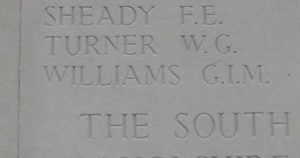
Jeffrey Williams, Leading Aircraftman, 952730, Royal Air Force Volunteer Reserve. Jeffrey was born on 22 December 1921, the son of Charles Ernest Williams and Agnes Rose Williams (nee Jones) of Coal Wharf, Aberbechan, Newtown. He was an apprentice bricklayer prior to enlisting into the Royal Air Force Volunteer Reserve and was posted to No. 4 Motor Transport Company. On 14 September 1941 Jeffrey had boarded a train at Crewe for Leeds. The train stopped to pick up passengers at Holmes Chapel Station and was stationary when it was hit from behind by the Crewe to Manchester train, which was running at 60mph. The last two carriages on the Leeds train were completely destroyed and nine people were killed, six in the accident and three more died later of their injuries. Forty-five passengers were injured, with 21 being detained in hospital. Jeffrey had been seriously injured in the crash and died soon afterwards. The remains of the 19-year-old were brought back home, and he was buried in Newtown and Llanllwchaiarn Cemetery.
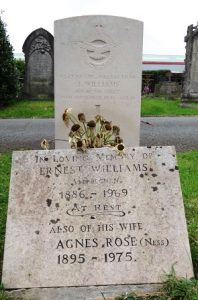
John Eric Williams, Guardsman, 2737516, Welsh Guards. John was the son of Annie Rebecca Williams, of 61, Ladywell Street, Newtown. He enlisted into the Welsh Guards soon after the outbreak of war and was posted to the Guards’ Depot at Caterham. John was killed during the Blitz on London on 11 September 1940. The remains of the 29-year-old were brought home and he was buried in Newtown and Llanllwchaiarn Cemetery on 23 September. John is not commemorated on the Newtown war memorial. He had lost two uncles during the Great War: John Edward Williams, had been killed at Gallipoli on 10 August 1915; and Henry James Crank, had been killed at Mametz Wood on 11 July 1916, whilst his cousin, John Garfield Williams was killed on active service in 1943.
John Garfield Williams, Leading Aircraftman, 1356897, Royal Air Force Volunteer Reserve. John was the son of Arthur Llewelyn Williams and Leah Ann Williams (nee Edwards), of the Buck Inn, High Street, Newtown. He worked at the Co-Operative Stores at Newtown prior to the war. John enlisted into the Royal Air Force Volunteer Reserve and was posted to 2879 Squadron, RAF Regiment at RAF Castle Camps, Cambridgeshire. The RAF Regiment came into existence on 1 February 1942 and was made up of field squadrons equipped with Morris Light Reconnaissance Cars, Humber Light Reconnaissance Cars and Otter Light Reconnaissance Cars and with a variety of anti-aircraft guns, with its role being to seize, secure and defend airfields. John was killed during a training accident whilst aboard an LCT (Landing Craft Tank) off the Isle of Wight on 28 September 1943. The body of the 23-year-old was brought home and he was buried in Newtown and Llanllwchaiarn Cemetery. He had lost two uncles during the Great War: John Edward Williams, had been killed at Gallipoli on 10 August 1915; and Henry James Crank, had been killed at Mametz Wood on 11 July 1916, whilst his cousin, John Eric Williams, had been killed in the Blitz in 1940.